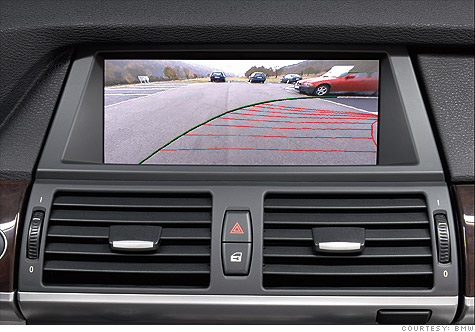Search News

Rearview cameras, such as this one on a BMW X5, are common in luxury vehicles - especially SUVs. A proposed federal regulation would essentially require them on all new vehicles has been postponed.
NEW YORK (CNNMoney.com) -- The National Highway Traffic Safety Administration has decided to postpone the creation of a new rule that would have required rearview back-up cameras in all new cars, pickups and SUVs by 2014.
The agency had been expected to announce the rule Wednesday. Instead, NHTSA issued a statement saying that "further study and data analysis" were needed before a final regulation could be issued.
"The Department remains committed to improving rearview visibility for the nation's fleet and we expect to complete our work and issue a final rule by December 31, 2012," NHTSA said
According to a proposal the auto safety agency announced in late 2010, drivers would be required to be able to see directly behind the vehicle whenever the vehicle is shifted into reverse. Since virtually all cars and trucks have significant "blind spots" -- areas in which the driver cannot see either by turning around or using the mirrors -- that would require video cameras.
Rear back-up cameras are especially helpful in trucks and SUVs because those vehicles can have very large blind spots due to their size and design.
Under that proposal, the rule would be phased in over the next few years, starting with 10% of new cars sold expected to comply with the mandate by September 2012; 40% by September 2013 and 100% by September 2014.
Cars also have increasingly large blind spots as the demands of style and improved aerodynamics -- needed for better highway fuel economy -- hinder rearward visibility in many newer models.
"Every vehicle has a blind zone immediately behind the rear bumper. It can be five feet or 50 feet, depending on the car's styling. Lost in that space might be a fire hydrant, a pet, or even a child," said Ami Gadhia, senior policy counsel for Consumers Union, in a statement.
While Consumers Union is eager for the new rule to be created, Gadhia said the group understands the need for more research.
While the systems first became popular on luxury cars they have become available on all types of cars. Usually, an image of what's behind the vehicle is displayed in a screen similar to a computer monitor. Some cars now display the video image in the rearview mirror itself, however.
The new rule was demanded by legislation passed in 2007 called Cameron Gulbransen Kids Transportation Safety Act. The act was named after a 2-year-old boy who was killed when his father accidentally backed over him in the family's driveway.
Consumer's Union, the non-profit group best known for publishing Consumer Reports magazine,
Benefits vs. costs: According to NHTSA's 2010 proposal, this "blind spot" regulation could save 95 to 112 lives per year, and prevent 7,000 to 8,000 or more injuries.
The agency estimates that the addition of rear-view camera equipment would cost between $159 to $203 per car, or $88 to $158 on vehicles already equipped with some sort of display screen, such as one used for navigation.
NHTSA says the total approximate cost to equip its estimate of 16.6 million vehicles sold in 2014 would be between $1.9 billion and $2.7 billion.
Within their proposal, NHTSA said that the additional costs of this regulation would be worthwhile, because so many of those killed are children.
Backover accidents cause an average 229 deaths and 18,000 injuries per year, according to NHTSA. The agency said that small children and the elderly are particularly vulnerable. Of those killed each year, 44% are under the age of 5, and 33% are over the age of 70. ![]()